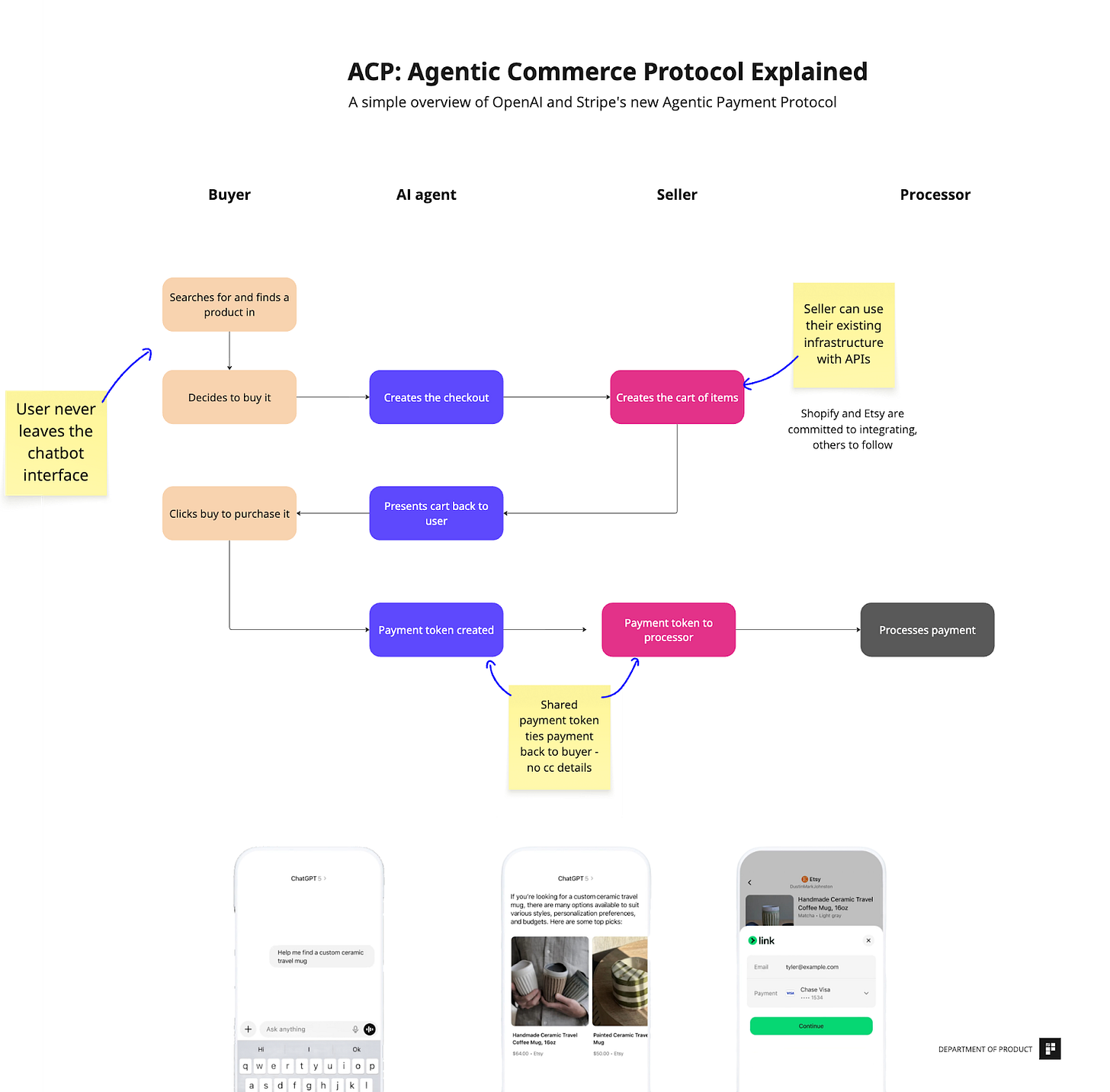What is ACP? Agentic Commerce Protocol from Stripe and OpenAI Explained
🧠 What it is, how it works, why it matters to product teams. Your guide to the essentials. Knowledge Series #88.
🔒The Knowledge Series is available for paid subscribers. Get full ongoing access to 80+ technical explainers and AI guides and tutorials to grow your AI and tech knowledge at work. New guides are added every month.
Last week marked a major new release for OpenAI with the launch of its new Checkout capabilities. And if you set aside the hype, you could argue that the most impactful part of this launch for product teams is the infrastructure upon which it’s built.
Checkout is powered by OpenAI and Stripe’s new payment protocol, Agentic Commerce Protocol or ACP.
Stripe’s product lead, Jeff Weinstein, marked the launch with a simple tweet announcing a new era for agentic payments:
Jeff goes on to say that Stripe has big plans for the protocol with new tooling, SDKs, MCP support, sample apps, test suite, and quickstart guide for the Agentic Commerce Protocol (ACP) all set to be released soon.
The new protocol already has the backing of ecommerce giants like Shopify and Etsy, and could soon become the de facto standard for product teams looking to integrate their products into AI agents beyond ecommerce.
But what exactly is ACP? And what are the most important parts of ACP worth knowing right now?
In this Knowledge Series, we’ll dig into the essentials of ACP and how it works with a closer look at the payment specification and what companies need to do to prepare for agentic payments. As well as some potential, real world use cases beyond traditional ecommerce.
If you’re curious about how payments are evolving to adapt to AI agents and would like a simple but in-depth guide to the essentials, then this Knowledge Series should help.
Coming up:
What is ACP? The Agentic Commerce Protocol Explained in simple terms
The documentation and specs unpacked: core concepts worth knowing
Why the new concept of a shared payment token matters for the future of agentic payments
How product teams could use the new protocol: potential use cases beyond traditional ecommerce
How ACP Works - a breakdown of the most important pieces of the technologies involved
We’ll take a closer look at Stripe’s specification later, but to get a snapshot of the most important pieces, here’s an overview of how an ACP setup might work in a typical checkout flow initiated by a user inside an AI agent / chatbot interface:
In a typical, non-agentic checkout flow, the seller would be responsible for crafting the end to end payment experience (albeit with an integration to a payment gateway). In an agentic checkout flow, though, the seller is less involved in the end to end process, with its role mostly reduced to managing the pricing and inventory of products since the user never formally visits the seller’s website in the traditional sense.
In this example, the user starts the process by searching for and finding a product they want to buy in ChatGPT. LLMs can already surface product information so not much changes here.
Once they decide what to buy, they click to add the item to their cart. Sellers who have integrated into the ACP spec will be able to support this concept of showing products to users and letting them add it to their carts.
With the products added to the cart, the agent presents the summary back to the user before they click to buy.
The user can then proceed with the purchase and in Stripe’s case, they can also use their Link account which negates having to enter their card details at all.
For merchants and anyone else who wants to sell products agentically, this means getting access to ChatGPT’s almost 1 billion users and any other agent that adopts the spec - but there are also some trade offs involved.
Here’s a video from a recent YC founder which shows an ACP workflow in a test environment:
A closer look at some of the core technologies involved and opportunities for product teams
ACP could transform the way users pay for products online. And since Stripe and OpenAI have such massive clout, it could mark the start of wider adoption across other products, too.
The specification says it can support all product types including physical products, software products and subscriptions and there are a few important pieces of the ACP protocol specification that are worth knowing about to get up to speed quickly.
Let’s dig into some of the most important concepts along with opportunities for product teams.



